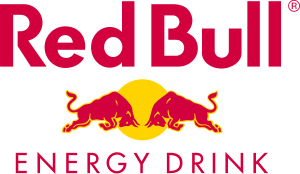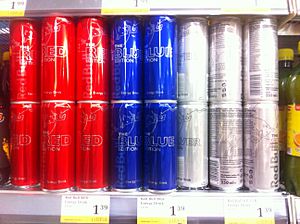Red Bull facts for kids
 |
|

8.4 fl oz (250 ml) can of Red Bull Energy Drink as sold in the United States
|
|
| Type | Energy drink |
|---|---|
| Manufacturer | Rauch Fruchtsäfte |
| Distributor | Red Bull GmbH |
| Country of origin | Austria |
| Region of origin | Fuschl am See, Salzburg |
| Introduced | 1 April 1987 |
| Color | Yellow |
| Ingredients | Caffeine, taurine, glucuronolactone, sucrose and glucose, B-group vitamins, and water |
| Variants | Red Bull Sugarfree Red Bull Total Zero Red Bull Zero Red Bull Energy Shot Red Bull Editions |
| Related products | Krating Daeng Red Bull Simply Cola Organics by Red Bull |
Red Bull is a very popular brand of energy drink. It was created by an Austrian company called Red Bull GmbH. It's one of the most well-known energy drinks in the world. In 2020, it was the most popular energy drink brand.
Since it first came out in 1987, over 100 billion cans of Red Bull have been sold. This includes more than 12.6 billion cans sold in 2024 alone.
Red Bull started with just one flavor in a silver and blue can. This was called Red Bull Energy Drink. Over time, many other versions were added. Its famous slogan is "Red Bull Gives You Wings." This is one of the most memorable advertising phrases ever.
Instead of just regular ads, Red Bull became famous through exciting events. These include extreme sports like the Red Bull Cliff Diving World Series and the Red Bull Air Race. They also did amazing stunts, like the Red Bull Stratos space jump project. Red Bull also owns sports teams and supports music through its Red Bull Records label.
Red Bull was inspired by a similar drink from Thailand called Krating Daeng. A pharmacist named Chaleo Yoovidhya created Krating Daeng. An Austrian businessman, Dietrich Mateschitz, tried Krating Daeng in Thailand. He said it helped him feel better after a long flight.
Mateschitz wanted to work with Yoovidhya. They created a new drink that would taste good to people in Western countries. They added bubbles to it, for example. In 1984, they started Red Bull GmbH in Austria. The name "Red Bull" comes from the Thai name "Krating Daeng." In Thai, daeng means red, and a krating is a large wild cow. Both Red Bull and Krating Daeng use a similar logo with a red bull and a yellow sun. They sell their drinks separately in different parts of the world.
Contents
The Story of Red Bull

In 1976, Chaleo Yoovidhya created a drink called Krating Daeng in Thailand. Its name means "red gaur," which is a type of wild cow. This drink was very popular with truck drivers and workers in Thailand.
In 1982, Dietrich Mateschitz was traveling in Thailand for his job. He met Chaleo, who owned T.C. Pharmaceutical. Mateschitz found that Krating Daeng helped him feel better after his long flight.
In 1984, Mateschitz and Yoovidhya decided to work together. They started Red Bull GmbH to make Krating Daeng a global brand. They each put in money to start the company. Yoovidhya and Mateschitz each owned 49% of the new company. Yoovidhya's son, Chalerm, got the last 2%. They agreed that Mateschitz would be in charge of running the company.
The first Red Bull drink was sold in Austria on April 1, 1987.
In Thailand, energy drinks were mostly for workers. But Red Bull decided to make their drink seem cool and fancy. They first sold it in Austrian ski resorts. Red Bull was sold as a special, higher-priced drink. Krating Daeng was still sold as a cheaper option. In many countries, you can find both drinks. The flavor for Red Bull is still made in Bangkok, Thailand, and sent all over the world.
During the 1990s, Red Bull started selling in many new countries. These included Hungary, Germany, the UK, Australia, and the United States. It came to the US in 1996, starting in California. By 2008, both Chaleo and Mateschitz were among the richest people in the world.
Red Bull GmbH has its main office in Fuschl am See, a small village in Austria. The Yoovidhya family owns 51% of the company. They also own the Red Bull trademark in Europe and the US.
Some people have questioned what the drink does and how it works. In the UK, advertising rules were put in place in 2001 because of complaints.
What's Inside Red Bull?
| Nutritional value per 250 ml (8.4 fl oz) | |
|---|---|
| Energy | 460 kJ (110 kcal) |
|
29
|
|
| Sugars | 27 |
|
0
|
|
|
Protein
|
0
|
| Minerals | Quantity
%DV†
|
| Sodium |
7%
105 mg |
| †Percentages estimated using US recommendations for adults. | |
Red Bull contains several ingredients that give it its special properties. These include caffeine, taurine, and B vitamins. It also has glucuronolactone and simple sugars like sucrose and glucose. These are mixed in carbonated water with other ingredients like sodium bicarbonate.
For Red Bull Sugarfree, artificial sweeteners are used instead of sugar. These sweeteners are called acesulfame K and aspartame or sucralose.
Caffeine in Red Bull
A regular 250 ml can of Red Bull has about 40–80 mg of caffeine. The amount of caffeine can be different depending on the country. This is because some countries have rules about how much caffeine drinks can have.
Like other drinks with caffeine, drinking too much Red Bull can have effects. Drinking a lot might make you feel excited or energetic. But it can also make you feel restless, worried, or have trouble sleeping.
Different Kinds of Red Bull
Over the years, Red Bull has made many different versions of its drink. They all use the same basic recipe but have different tastes and colors.
Red Bull started making different drinks in 2003. They released Red Bull Sugarfree, which had no sugar and a different taste from the original. In 2012, they launched Red Bull Total Zero, which had no calories at all. Then, in 2018, they released Red Bull Zero. This version was also sugar-free but was made to taste more like the original Red Bull.
In 2009, Red Bull also made a very strong version called Red Bull Energy Shot. It came in small 2 oz (60 ml) cans.
The company started adding more flavors in 2013 with the Red Bull Editions. These first came in cranberry, lime, and blueberry flavors. Now, the Editions line has many different flavors. Some are only available during certain seasons or in specific places. Today, you can find flavors like blue (blueberry), peach (peach-nectarine), winter (iced vanilla berry), sea blue (juneberry), and red (watermelon).
Other Drinks from Red Bull
In 2008, Red Bull released a cola drink called Simply Cola. A new version of this cola came out in 2019. It was part of Red Bull's Organics line.
In 2018, the company launched Organics by Red Bull. This is a line of organic sodas. It has four flavors: bitter lemon, ginger ale, tonic water, and a new version of Red Bull Simply Cola.
Red Bull Around the World
At first, some countries like France, Denmark, and Norway did not allow Red Bull to be sold. They were worried about an ingredient called taurine. So, Red Bull made a version without taurine for France.
However, as of 2021, Red Bull is sold in all 27 countries of the member states of the European Union. It is also sold in 171 countries around the world. The French food safety agency eventually allowed Red Bull with taurine in 2008. They could not prove that taurine caused any health risks.
Legal Matters
In 2013, Red Bull asked a small brewery in England called Redwell Brewery to change its name. Red Bull thought the name sounded too much like Red Bull and could confuse customers. The two companies eventually agreed that Redwell could keep its name.
In 2014, Red Bull settled a lawsuit in the United States. Some customers had sued the company. They said that Red Bull claimed its drink gave special performance benefits that were not proven by science. Red Bull agreed to pay money to customers who had bought the drink. Customers could choose to get $10 cash or $15 in Red Bull products. It's important to know that the customers did not say the drink literally gave them wings.
See also
 In Spanish: Red Bull para niños
In Spanish: Red Bull para niños


